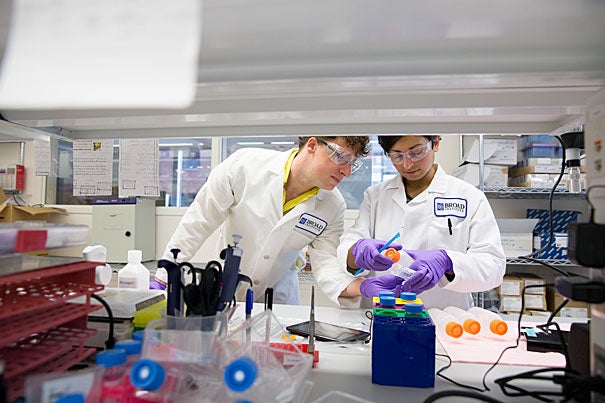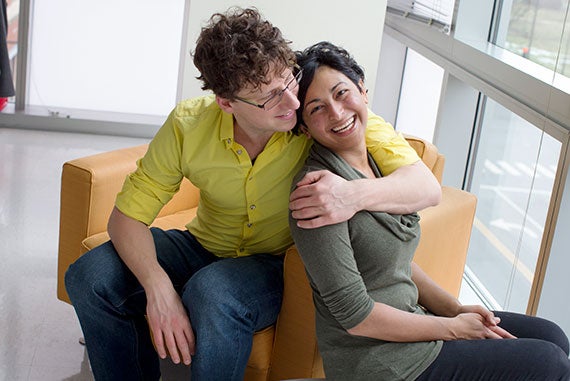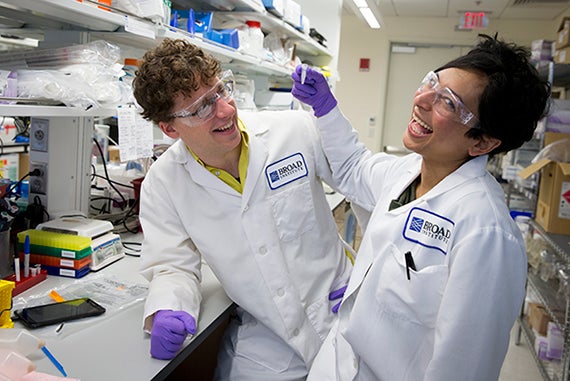
“It felt like a sabbatical from my normal life to get up to speed on science,” says Harvard Ph.D. student Sonia Vallabh of her research on prion disease. Vallabh and her husband, fellow Harvard Division of Medical Sciences student Eric Minikel, both changed careers to focus on prion research after the disease proved fatal for Vallabh’s mother.
Rose Lincoln/Harvard Staff Photographer
Strength in love, hope in science
Husband and wife Ph.D. students seek treatment for her fatal disease
When young love faces death, tragedy too often follows. But what if science throws in on the side of the lovers?
Husband and wife Eric Minikel and Sonia Vallabh, both Harvard Ph.D. students, have through fate and choice become a test case. The couple has embarked on a journey both personal and scientific, one that began five years ago in a mother’s horrifying decline into dementia and death from a rare brain disease, the tracks of which appear in Vallabh’s DNA.
Their search for a treatment is off to an encouraging start. Still relative newcomers to the lab, Vallabh and her husband have two research papers under their belts, and have exhibited enough energy and intellect to make some of the world’s top scientists enthusiastic supporters and cautious believers. The genetic bomb of prion disease that killed Vallabh’s mother is almost always fatal, but usually doesn’t strike until middle age, still years away for her 31-year-old daughter. In the meantime, every moment counts.
“When a force of nature meets a force of nature meets a tragedy, what do you get? You get Sonia and Eric,” said Stuart Schreiber, the Morris Loeb Professor of Chemistry and Chemical Biology and the head of the Broad Institute lab where Vallabh and Minikel are conducting research. “I don’t know the final outcome, but I think the early steps toward remedy look promising. They bring otherworldly intellect with a heavy dose of urgency to prion disease.”
A devastating decline
It’s a long way to brain science from transportation planning, in which Minikel trained at MIT, and alternate dispute resolution, which was Vallabh’s focus after graduating from Harvard Law School in 2011.
The journey began in early 2010. The couple, living in the 630-square-foot Central Square apartment they’d shared since moving to Cambridge from California in 2008, started to hear from Vallabh’s mother, Kamni, that she was losing weight and having trouble with her vision.
“It just seemed like minor things,” Vallabh said. “Winter in western Pennsylvania can be a tough time for everyone. I was thinking, ‘It’s not a great winter for Mom.’”
But when Vallabh visited home in May, her mother’s deterioration was frightening.
“It happened really quickly that she wasn’t able to get to the end of a sentence without losing her train of thought, trailing off into murmuring or into non-sequiturs,” Vallabh said. Her mother “couldn’t remember for any period of time that she wasn’t strong enough to stand or walk. If you turned your back for a second, she would try to stand and fall.”
The family’s search for answers took them to specialists in Pittsburgh, Cleveland, and Boston, but the doctors were stumped. Lyme disease and heavy-metal poisoning were among the possibilities considered and then dismissed. An early spinal tap to check for prion disease came back negative.
“Every time there was a new hypothesis … there was an uptick in hope for the whole family,” Vallabh said. “Then it would fade away.”
Kamni’s condition worsened. In and out of hospitals, she underwent a tracheotomy and was put on a respirator. She developed pneumonia and, finally, in December, after nearly a year of rapid decline, underwent another spinal tap. It came back positive: a tentative diagnosis of sporadic prion disease.
Vallabh’s mother died on Dec. 23, 2010, still lacking a confirmed diagnosis. Her father, Sagar, decided to have an autopsy done, but the results would take some time. Vallabh returned to Cambridge to finish her legal studies, graduating from Harvard Law in May and starting work at a small consulting firm in Boston.
A few months later she was back in Pennsylvania for a friend’s engagement party. At the airport for her return flight, her father asked if he could talk to her alone. Kamni had indeed died from prion disease, he told her. And, though most cases develop spontaneously, her mother’s was genetic.
Lethal proteins
It took science some time to come around to the idea that disease might spring from proteins, which seemed strange bedfellows with viruses and bacteria. Proteins are important elements in the diet and essential to the body, providing the building blocks for muscle, red blood cells, hormones, enzymes, and a wide array of other tissues.
But they can go wrong. Proteins are long molecules, containing hundreds or even thousands of atoms that fold themselves into 3-D structures. These structures are characteristic for each protein and influence how they work. Folds can expose or hide parts of a molecule, making them more or less likely to interact. In prion disease, prion proteins begin misfolding into a malignant form.
The genetic mutations that can cause genetic prion disease all occur in the prion gene, PRNP, and are dominant. That means that only one copy is needed to seed disease and that Vallabh had a 50 percent chance of inheriting the copy from her mother.
Though several different prion-related diseases are recognized by medical science, Minikel and Vallabh have come to believe that they’re all variants of the same condition, traced to different mutations of PRNP and the misfolded protein it encodes.
On the flight back to Boston, Vallabh told her husband the news.
“I couldn’t get enough air in my lungs to breathe,” Minikel said. “I was holding Sonia … not letting go. The flight attendant kept coming by — ‘Are you OK?’ We weren’t, but what could we say?”
With no treatment or cure, someone else might have passed on testing for the gene.
But Vallabh’s decision was immediate: She had to know.
“We can never go back to a time [when] we didn’t have the question,” Vallabh said. “Rather than live with the question, I wanted to have the answer.”

In December 2011, several torturous weeks after providing a sample, Vallabh met Minikel amid the bustle of Park Street station. They rode the E train out to Brigham Circle and walked a short distance to Brigham and Women’s Hospital.
When the geneticist and a genetic counselor came in, they delivered the news simply: “The same change that was found in your mother was found in you.”
As the information sank in, Vallabh heard the geneticist say that he was “cautiously optimistic” a treatment would be developed eventually. But in the moment, there was no escaping the likelihood that her mother’s fate would be her own.
After the couple shared the test results, friends converged on the Central Square apartment, and Vallabh’s father flew to Boston. The weekend passed in a sort of mourning, as the couple and those closest to them absorbed the news and tried to understand what it meant for the future.
“That grieving process lasted a week,” Vallabh said. “Then we had a visit from Stevie.”
Help from a friend
Stevie Steiner was a doctoral student at MIT and an old friend of Minikel’s. The two had met in 2000 as freshmen at the University of Wisconsin at Madison, bonding as fellow nerds. They lost touch after graduation, but reconnected in Cambridge thanks to a chance meeting on a corner near the MIT campus.
When Steiner heard about Vallabh’s diagnosis, he was unconvinced. As a scientist, he held faith in the power of science, but he also remained clear-eyed on its limits, not least when it came to rare conditions such as genetic prion disease.
“My first reaction was, ‘We don’t know what we don’t know,’” Steiner said.
Steiner, working on his doctorate in materials chemistry and engineering, was no expert on the disease. But he knew that there was a lot more going on in prion labs than physicians would discuss with patients. He also knew that much of that work was available in scientific journals. So he searched for articles in a database, and then loaded them onto a flash drive.
Steiner “brought with him a very different energy,” Vallabh said. “Everyone [else] was, ‘Wow, this is hard.’ Stevie came in the door with his own agenda.
“He said, ‘Guys, science has answers. Don’t lie down and take it. Things are happening.’ This was so different, we almost couldn’t handle it.”
Steiner left the flash drive, but neither Vallabh nor Minikel touched it for several days.
“Some of my reluctance was disbelief,” Vallabh said. “My mother saw some of the best neurologists in the country and still died without a diagnosis. These diseases were too rare. It didn’t seem plausible to me that people were working on them.”
Finally, they plugged in the drive.
“What I didn’t appreciate was the [divide] between research and the clinical side. Looking at the articles I realized that maybe there’s nothing making it from the lab to the clinic now, but there’s a huge backstage warren of activity pointing in that direction. As soon as we realized that people are out there devoting their careers to working on prions, defining prions, understanding disease, and thinking about treatment, we started looking ourselves.”
The couple set off on their own search of journals, a search that soon became addictive for Vallabh. “It had an optimistic energy to it that I liked. It was helping, it [made] me feel better. It felt like a sabbatical from my normal life to get up to speed on science.”
In January 2012, she quit her job.
Lab lessons
Before long Vallabh was sitting in on MIT classes. Next she enrolled in a molecular biology course at Harvard Extension School. One night after class, she approached teaching assistant James Walker, a Massachusetts General Hospital (MGH) scientist and an instructor in neurology at Harvard Medical School (HMS).
“She told me the story from the beginning,” Walker said. “It was captivating. She was hesitant to say ‘This is what I want to do,’ but she was wondering whether there were opportunities.”
Vallabh asked Walker about possible volunteer positions in a lab. Though Walker knew Vallabh was a newcomer to science, he also knew she was smart and driven. He’d see what he could find.
It didn’t take long. Marcy MacDonald, an HMS professor of neurology and a Huntington’s disease researcher at MGH’s Center for Human Genetic Research, had an opening for a technician and agreed to take on Vallabh. The first day in the lab was surreal.
“I kept thinking, ‘Any minute now, I’m going to say something dumb and they’re going to take [this] away from me,’” Vallabh said. “It was very hard for me to accept that they hired me on the premise that I was a beginner and I’m really going to try hard.”
Vallabh survived the day, and over the weeks to come, won the respect of her lab mates. Marta Biagioli, then a third-year postdoctoral fellow, said she didn’t know what to make of Vallabh when she arrived. MacDonald had warned her that Vallabh was a beginner, so on that first day, Biagioli lined up a few simple tasks to ease her into her duties: use a pipette, make a solution.
The newbie proved a fast learner.
“She practically jumped from very basic pipetting to more complicated experiments in a couple of months,” Biagioli said. “That was really impressive to me.”
Vallabh soon realized her “sabbatical” from legal work was morphing into something more permanent. Her time in the lab felt meaningful beyond anything she could imagine in law. She and Minikel began to think about what came next.
‘Engaging with science … is really different from thinking about my own mortality every day. In some ways one has displaced the other.’ —Sonia Vallabh
The couple had already founded the Prion Alliance, aimed at supporting work toward a treatment. Minikel began to blog about the disease and eventually followed Vallabh to MGH, leveraging his analytic skills and experience in an Extension School bioinformatics course to find work in a different lab. Formal scientific training emerged as the next shared goal.
At first the couple looked at schools where prions were a major focus, which left out Harvard’s Division of Medical Sciences, the Harvard Medical School-administered Ph.D. program of Harvard’s Graduate School of Arts and Sciences. Among the top candidate schools was the University of California at San Francisco, the base of Stanley Prusiner, who won a Nobel Prize in 1997 for his discovery of prions as a new kind of infectious agent.
Then, at a reception for prospective graduate students, Vallabh and Minikel struck up a conversation with Harvard’s Schreiber. He challenged the notion that the only path was an established prion laboratory.
An alternative, he offered, would be to join a multidisciplinary team of scientists who might not be expert in prions, but who knew a lot about modern therapeutics. He knew exactly where to look — his own lab. The plan held risks, not least that the prion expertise would depend on a pair whose primary training was in transportation planning and law. But the combination of therapeutics and prion research might just accelerate a treatment.
In the fall of 2014, Vallabh and Minikel entered Harvard’s biological and biomedical sciences Ph.D. program. And when it was time to find a lab for their research, they turned to Schreiber.
Onward, together
In January, Minikel and Vallabh were the first authors on a study with a fraught question at its heart: If you have the gene, what are your chances of getting the disease?
Some genes confer near-certainty that disease will develop, but most of the time cause is blurred, a blend of genetic roots — often from multiple genes — with environment and lifestyle. Minikel and Vallabh’s study used multiple databases of both sick and healthy people to investigate 63 different prion disease mutations, including the one Vallabh carries.
They were able to draw conclusions for 10, finding that three mutations thought to cause disease were likely benign and that three more caused disease in far fewer cases than originally thought. For four mutations, however, including Vallabh’s, they found “penetrance” to be nearly 100 percent. In other words, those who have the mutation will almost certainly develop the disease.
But the study also carried good news. It documented three people in good health even though one of their prion genes was shut off. Such a “loss of function” mutation means that drugs that might one day reduce prion protein in the body will likely be safe.

The research also eased the mind of at least one worried woman, according to Robert Green, a geneticist at Harvard-affiliated Brigham and Women’s Hospital. The daughter of a deceased patient who tested positive for prion disease had been concerned that the disease was genetic and that she herself was at risk. Minikel and Vallabh’s study showed that although the mother did have a mutation for prion disease, that particular mutation was likely benign, allowing Green to call and ease the daughter’s concerns.
For Schreiber, the article carried another benefit: It provided evidence of the couple’s scientific chops. The publication, their second, struck him as a sign of more to come. “Any one of these would be the paper of a lifetime,” he said, adding: “We believe in Sonia and Eric. I’m in it for the long haul.”
It’s a belief Minikel and Vallabh have taken to heart, making a second home of the Broad, which has provided separate lab space for their research and extra backing in the form of a BroadIgnite grant.
The couple once imagined speeding through doctoral studies to focus on prions in their own lab, but no longer. They have been able to dive right into prion research and draw on the material and intellectual resources — including platforms in genomics, metabolomics, proteomics, and small-molecule screening — of one of the world’s top biomedical research centers.
“I feel like we’ve landed,” Vallabh said. “We found our place where we can do science. We just got to do it, make the most of the opportunities here.”
Those opportunities leave scarce time to dwell on disease and the uncertainties of tomorrow.
“Engaging with science … is really different from thinking about my own mortality every day,” Vallabh said. “In some ways one has displaced the other.
“We’re optimistic and hopeful that we’re moving the ball forward. We can put energy there instead of spinning wheels for things I can’t affect.”
Meanwhile, the idea of raising a family is more and more on their minds. Vallabh and Minikel have fertilized embryos — safely frozen for now — that tests have shown are free of the genetic mutation for prion disease. Sometime in the next couple of years, they may take yet another leap.
“Some people have five or six generations of disease in their family,” Vallabh said. “To take it into our own hands to end transmission through your germline I think is miraculous. It’s so powerful. What an amazing gift to be able to give your kids.”




